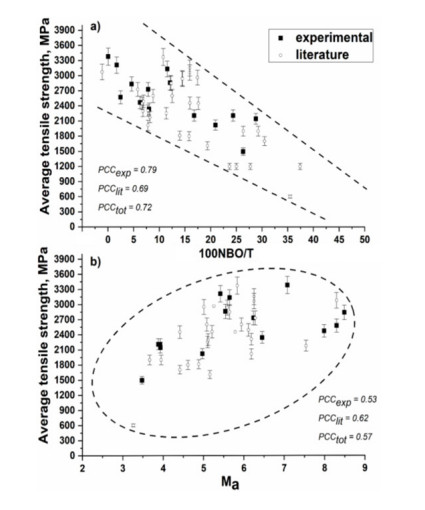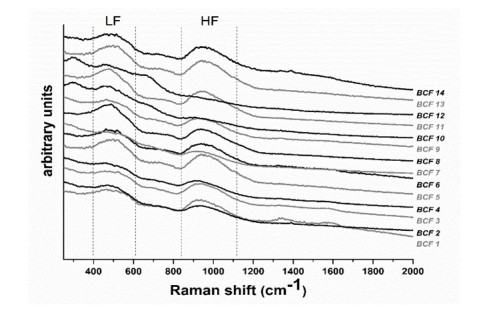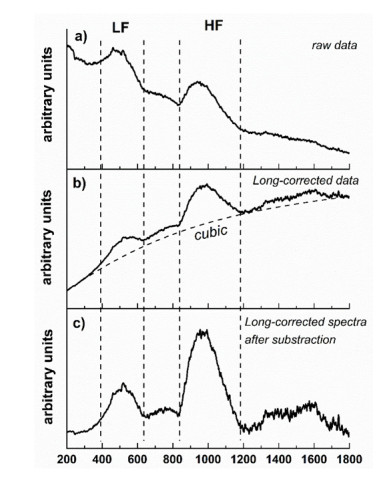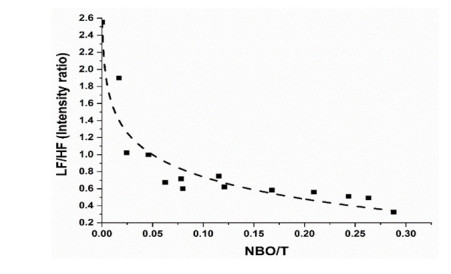This work presents the study of the dependence of the basalt continuous fibers (BCF) tensile strength on their chemical composition. 14 different basalt deposits were used to obtain continuous fibers by a laboratory scale system. Based on the data for more than 15 articles focused on natural basalt continuous fibers (32 different compositions) and experimental data of 14 experimental BCF series, the correlation of the tensile strength, the acid modulus and the NBO/T parameter was calculated. The PCC (pearson correlation coefficient) value of NBO/T and the tensile strength was 0.79, for acidity modulus and tensile strength -0.53.
Raman data for experimental BCF confirm the significant influence of the chemical composition of basalts on their structure, which determines their tensile strength. With a decrease in NBO/T, the observed ratio between the Raman bands at low-and high-frequencies gradually increases.
1.
Introduction
Basalt continuous fibers (BCF) are a special kind of glass fibers which were first obtained in USSR in the 20th century. In distinction from widely used glass fibers (E-glass, AR-glass, S-glass, etc.), rocks are used as a raw material for the BCF production. Glasses based on basalts are multicomponent systems with the following composition (mass%): SiO2 43–58, Al2O3 11–20, CaO 7–13, FeO + Fe2O3 8–16, MgO 4–12, R2O up to 4. Titanium dioxide often presents as well. However, the most basalt deposits have inconstant chemical composition [1]. Currently, BCF are perspective fillers for polymer composite materials and concretes because of their high mechanical properties [2,3] and alkali resistance [4,5,6].
BCF production technology is hampered due to the high crystallization ability of basalt melts and high fluctuations of the composition. As a result of these fundamental problems, the BCF production technology capacity is low and the BCF cost is high.
Several popular approaches are usually used to enhance mechanical properties of basalt continuous fibers. The first technique is thermal or chemical treatment [7,8,9]. The second technique is ion-exchange, which consists in displacing small alkali metal ions from the surface layer of heated glass by ions of large alkali metals [10]. An effective way to improve the mechanical properties of basalt fiber/epoxy resin composites is using special coating [11,12].
The study of the chemical composition influence on the mechanical and chemical properties of BCF usually comes down to the study of the effect of individual components of the composition [13,14]. According to some researchers, at least 46% silica (SiO2) should be in BCF composition for a stable spinning process [15]. Higher percentage improves the spinning process and enhances the mechanical properties of fiber [16]. Most articles focus on the study of the effect of iron oxides [17,18]. The role of the ratio Fe3+/Fe2+ is a subject of discussion [19,20], because the viscosity, density, mechanical properties, crystallization properties, and maximum service temperature have a strong dependence on iron redox amount [19,20,21]. It is believed that ferrous cations act as network modifiers with octahedral coordination while ferric ions are tetrahedrally coordinated network-former cations [22,23] when the ferric-ferrous ratio exceeds 1:2 [24].
To predict the mechanical properties, it is necessary to appreciate the reciprocal influence of different oxides in the basalt rock composition. Currently, the most commonly used parameter for that is acidity modulus (Mk). Usually, acidity modulus is calculated by the formula: Mk = (Al2O3 + SiO2)/(CaO + MgO), where Al2O3, SiO2, CaO, MgO are oxides mass content [25,26,27]. In scientific articles, the composition of basalt fibers is also most often given in mass percentage [3,15,28].
To characterize the structure of aluminosilicate glasses, Mysen [29] proposed to consider the melt polymerization and the proportion of non-bridging oxygen atoms (NBO) to tetrahedral cations (T), known as the "NBO/T" parameter. There Si4+ and Al3+ are tetrahedrally coordinated network formers cations and Mg2+, Ca2+, and K+, Na+ ions are network modifiers that generate nonbridging oxygens. Mole fractions are used for calculation NBO/T [30]. This parameter is also calculated by a formula which takes into account the structural role of iron oxides [22,23]. It is extremely important for basalt systems.
In this work, it is proposed to use the NBO/T parameter to evaluate and predict the mechanical properties of basalt continuous fibers. BCF based on the 14 different basalt deposits were obtained and their mechanical properties were determined. Changes in the structure of basalt fibers were investigated by Raman spectroscopy.
2.
Materials and methods
2.1. Preparation of glasses
Basalt rocks were ground and heated in a platinum crucible in a high temperature furnace at a rate of 250 ℃/h up to 1000 ℃ and at 30 ℃/h in the range of 1000–1600 ℃, then homogenized at 1600 ℃ for 9 h. The molten glasses were quenched in water from 1600 ℃.
2.2. X-ray fluorescence analysis
X-ray fluorescence analysis of the specimens was performed on a PAN Analytical Axios Advanced spectrometer. Characteristic X-rays were excited using a 4 kW Rh-anode X-ray tube. The excited radiation was recorded by a scanning channel with five exchangeable wave crystals and a detector. Measurements were made in transmission geometry in vacuum. Specimens were prepared in the form of pellets with a binder. The results are shown in Tables 1 and 2.
2.3. X-ray diffraction
X-ray diffraction (XRD) was made at room temperature on Thermo ARL X'TRA powder diffractometer (CuKα1 radiation, λ = 1.54060 Å; CuKα2 radiation, λ = 1.54443 Å). XRD patterns were collected in an angular range 2θ = 10–60° at a scan step 2θ = 0.02° and a scan rate of 1° (2θ)/min.
2.4. Production of fibers
Basalt continuous fibers were produced from prepared bulk glasses using a laboratory scale system [31]. Fiber formation was carried out under the temperature between 1400 and 1500 °С. Aminopropyltriethoxysilane sizing was applied in the fiber production.
2.5. Measuring of mechanical properties
The tensile strength of the fibers was determined on a Hounsfield H100K-S universal tensile testing machine. Specimens were mounted in paper support frames using epoxy. The gauge length was 10 mm, and the crosshead speed was 5 mm/min (ISO 5079). The fibers had filament diameters of 10–12 μm. Measurement error of tensile strength is ±3%.
2.6. Raman spectroscopy
Raman spectra were collected on equipment, based on spectrometer TRIAX 552 (Jobin Yvon) and detector CCDSpec-10, 2KBUV (2048x512) (Princeton Instruments) in the range 200–2000 cm-1 with spectral resolution 1 cm-1. The source of stimulating radiation was laser STABILITE 2017, laser stimulation of spectrum 514 nm. Fitting of the main envelopes and determination of band intensities were performed after long correction and baseline subtraction from raw data. For the treatment of data cubic baselines were used.
2.7. Calculation procedures
Acidity modulus is calculated by formula (Eq 1):
where SiO2, Al2O3, CaO, MgO are oxides mass fractions.
NBO/T is calculated according to [22,23], which are determined by Eq 2. The result is presented in the Table 3.
In Eq 2 content of all oxides is given in mole fractions. Polymerization degree, that is defined as the number of non-bridging oxygen atoms per one formula unit number, has the maximum value at NBO/Т = 0 (quartz SiO2) and minimum at NBO/T = 4 (forsterite Mg2SiO4). If ratio Fe2+/Fe3+ is not definitely determined it should be equal to 36:64 according to the Mö ssbauer spectroscopy data [20].
3.
Results and discussion
3.1. Mechanical properties
At present, in the technical and regulatory documentation the acidity modulus is used for the description and selection of the raw materials for the basalt and glass fibers production. To calculate this parameter the formula, which includes the oxides mass content, is usually used [25,26,27].
In scientific articles, researchers also usually present composition data in mass percent. However, from a chemical point of view, the molar content of glass components is more significant. For example, based on the molar concentration, the quantitative structural characteristic of glasses (NBO/T) is calculated. NBO/T is a ratio of nonbridging oxygens per tetrahedrally-coordinated cations. As shown, for example, by Mysen [29], this ratio represents polymerization degree of a silicate glass structure. For basalt glasses, a model was proposed that considered the high content of iron oxides. Based on the data from more than 15 articles concentrated on natural basalt continuous fibers (32 different compositions) (Tables 2 and 3), the correlation of the tensile strength of the filaments and the acid modulus and the NBO/T parameter was calculated. Using a simple linear approximation, it was found that the significance of the structural parameter is stronger. The PCClit (Pearson correlation coefficient) value of the NBO/T parameter was 0.69, and for Ma was 0.62 (Figure 1).
Thus, we concluded that NBO/T can be used as the parameter to estimate the BCF mechanical properties. The calculated Pearson correlation coefficients are close to each other. In our opinion, this is due to many different factors that can affect the value of BCF tensile strength. These factors do not coincide in different sources and often are not specified. Not only the chemical composition but also other factors could affect the BCF tensile strength: the laboratory plant scheme, the tensile strength measuring method, the fiber diameter, the melt temperature and others.
To confirm the proposed approach, a series of BCF samples based on 14 different basalt deposits were obtained under equal conditions. Basalt continuous fibers were produced using a laboratory scale system [42]. According to X-ray diffraction, all obtained samples are amorphous. The basalt filaments chemical composition in mass% is given in Table 1. To minimize the impact of different factors on the tensile strength, the following conditions were chosen: the same fiber diameter (about 10–12 μm), the same tensile strength measuring method (according to ISO 5079), the same melt temperature (about 1600 ℃).
The tensile strength of the experimental BCF varies in the range from 1495 to 3380 MPa. Literature data spread is wider (from 602 to 3370 MPa) [15,36]. This is due to the fact that the fibers are obtained in different conditions. Moreover, the chemical composition of the fibers affects not only their structure, but also the production conditions. In [36], 8 samples of basalt fibers of various compositions were studied. The chemical composition varies within the following limits (mol%): SiO2 56.6–68.9, Al2O3 9–12.2, CaO 6.2–10.7, FeO + Fe2O3 4.4–8.1, MgO 6.1–9.7, Na2O 0.9–4.4, K2O 0.9–4.4, TiO2 0.7–2.4. For experimental samples, SiO2 51.9–66.9, Al2O3 6.7–12.1, CaO 3.9–13.4, FeO + Fe2O3 4.3–11.9, MgO 3.1–14, Na2O 1.7–6.4, K2O 1.1–1.3, TiO2 0.7–2.9. The tensile strength of the experimental samples and samples obtained in [36] is also close. The worst fiber tensile strength in series was 2253 MPa. The average value of the tensile strength of the BCF series was about 2900 MPa, and the highest filament tensile strength was 3370 MPa. For experimental samples the worst fiber tensile strength was 1495 MPa and the highest filament tensile strength was 3380 MPa.
The dependence of the obtained filaments tensile strength on the NBO/T parameter and acid modulus was calculated. The PCCexp (Pearson correlation coefficient) value for the NBO/T parameter was 0.79, and for Ma -0.53. Based on experimental data, it can be concluded that for the samples obtained under identical conditions, the correlation between the structural parameter and the tensile strength is much higher than the correlation between the acidity modulus and the tensile strength.
Tables 2 and 3 shows the experimental data for continuous fibers based on 14 different basalt deposits and literature data for 15 basalt fibers with different compositions. The PCCtot value of the NBO/T and tensile strength was 0.73, for Ma -0.60. We would like to note that in the scientific articles the chemical composition of all BCF was presented in mass percent (Figure 1).
The correlation between the chemical composition and tensile strength of a glass continuous fiber has been studied for a long time. According to many authors, the increase in the content of glass-forming oxides (aluminum or silicon oxides) should lead to increased strength [14]. In this case, the quartz fibers should have maximum strength. In practice, this is not true. The maximum strength for glass fibers is observed for S-glass fibers. This fact is due to the strength of glass network of aluminosilicate glass fibers, is governed by local atom coordination. There is no universal law for the effect of composition on tensile strength because the glass structure changes with composition as does the valence of certain oxides.
The absence of a long-range order in the structure of glass leads to the fact that the strength of fibers is determined not only by their chemical composition, but also by the valence of cations. This is especially important for basalt fibers, since they contain a large amount of iron oxides. The presence of higher field strengths ions, such as Mg2+ or Zn2+ [10], leads to strengthening of the glasses. At the same time, the effective increase of glass strength can be achieved by increasing the relative amount of network formers, such as AlIV [13]. Aluminum cations can be found both in tetrahedral and octahedral coordination in the structure of aluminosilicate glasses. Aluminum in fourfold coordination (AlIV) is a network former but AlVI is a network modifier. The ratio of the number of cations with different coordination depends on the chemical composition of the glass [42].
Table 4 shows the Pearson correlation coefficient of the tensile strength and the oxide content (molar and mass) for the experimental data of the BCF based on 14 different basalt deposits, the literature data of 15 basalt continuous fibers with different compositions and the both series.
The strong dependence is observed for the molar content of silicon oxide, alkali metal oxides (R2O) and alkaline earth metal oxides (RO). Both for experimental and literature data the PCC of the SiO2 molar content and the tensile strength was about 0.5. The PCC is lower for the same oxide content expressed in mass fractions. That confirms our approach. The influence of the SiO2 content on BCF mechanical properties is noted by many researchers. As shown in article [36], BCF tensile strength decreases with decreasing silicon oxide content, which is explained by the fact that SiO2 can strengthen basalt glass network structures, as well as form network structures and increase the tensile strength of basalt fibers. The same effect could be expected for Al2O3. However, strong correlation in this case is possible only in a definite composition interval, since aluminum atoms can act both as network former and as modifiers [13].
The content of alkaline-earth RO cations has a significant effect. Calculated PCC of the tensile strength and RO content are high for both literature and experimental data. An increase in the content of CaO and MgO oxides in basalts may lead to an increase in the ability to basalt fibers crystallization on their base [32]. That leads to a significant reduction in the BCF tensile strength. High concentration in the composition of the modifiers (Na2O, K2O, CaO, MgO) leads to reduce the tensile strength of the fibers [10]. Our calculations also confirm the effect of alkaline cations on tensile strength (Table 4).
In our opinion, the NBO/T parameter is a complex character of the glass structure with the definite composition. NBO/T better considers the correlation of the chemical composition and the BCF tensile strength for multicomponent systems. A comparison of the literature data and the obtained experimental data shows that the production of fibers with high strength (above 2800 MPa) is customary to the following composition range mol%: SiO2 58–66.1, Al2O3 6.7–12.8, CaO 3.9–10.7, FeO + Fe2O3 5.2–11.9, MgO 3.9–10.6, Na2O 2.5–4.7, K2O 0.5–2.1, TiO2 0.8–2.9. The results are consistent with each other and can be the basis for creating regulatory documentation similar to ASTM D578.
3.2. Raman spectra
One of the widely used method of investigating the structure of glasses is the Raman spectroscopy. The Raman spectra of all basalt continuous fibers obtained based on 14 different deposits are presented in Figure 2. The Raman spectra of all analyzed basalt fibers are characterized by three regions: low-frequency region (LF: ~200–600 cm-1), middle-frequency region (MF:
~600–800 cm-1) and high-frequency region (HF: ~800–1200 cm-1). The intensity observed in the spectra increases from high wave numbers to low ones. Similar areas can be observed in synthetic natural glass [21,43].
The LF-envelope can be explained as a convolution of delocalized vibration modes, associated mainly with symmetric stretching of bridging oxygen bonds, bending vibration of silicon polyhedra, the rings breathing modes [44]. The intensity of HF-envelope shows the relative concentrations of silica tetrahedra with one (1100 cm-1), two (about 1000–950 cm-1) and four (about 800–850 cm-1) non-bridging oxygen atoms [45]. The high-frequency region falls into the stretching vibrations of disilicate, metasilicate, pyrosilicate and orthosilicate. This region reflects the modification of inter-tetrahedral bond angles, force constants, T–O distances and polymerization due to the action of network modifying and charge balancing cations [21].
The methodology of spectrum analysis differs slightly from one researcher to another. It depends on the composition of the glass. For quantitative analysis of basalt and other natural glasses Raman spectra, it is usually applied recalculation of the raw spectra (I(ν)) to a format (R(ν)) as proposed by Long [43]. Therefore, curves fitting and calculation of band intensities of Raman data for all obtained basalt fibers were performed after Long correction and cubic baseline subtraction (Figure 3).
It is known that the degree of polymerization of aluminosilicate glasses affects the intensity of the bands in the Raman spectra, hence, the amount of non-bridge oxygens (O-) also influences. With a decrease in NBO/T, the observed ratio between intensity of the two main Raman spectra regions at low and high frequencies gradually increases in both synthetic and natural glasses [45,46]. The authors showed that the ILF/IHF ratio (ILF—low-frequency region intensity, IHF—high-frequency region intensity) exponentially decreases from 3 to 2 in low NBO/T rhyolitic glasses and down to 0.6–0.3 in high NBO/T mafic basanites and tephrites. The rate of decline is very sharp in in the NBO/T range 0–0.1, while the ILF/IHF ratio is near invariable in glasses with high NBO/T amount [47]. Figure 4 shows the correlation of the ILF/IHF ratio and NBO/T of continuous fibers obtained on the basis of 14 different deposits. ILF/IHF ratio exponentially decreases from 2.6 to 1 in low NBO/T basalt fibers and down to 0.8–0.3 in high NBO/T (Figure 4).
The chemical composition of basalt glasses and fibers on their base directly determines the intensity of peaks in low and high regions of Raman spectra. The increase in the composition of alkaline earth ions and alkali ions leads to depolymerization of the glass structure with the formation of the NBO, which leads to a decrease ILF/IHF. The increasing the modifiers content in basalt composition causes a shift of high-frequency band positions toward lower wave numbers in Si–O–Si stretching band. The fact that the main Si–O–Si absorption band begins to shift to lower wave number is interpreted to mean that some of the aluminum ions are in different local surroundings [10]. With the addition of alkali oxides, the nonbridging oxygen ions are converted to bridging oxygen ions, as the aluminum ions must use some of the nonbridging oxygen ions to form AlO4 tetrahedra. In glasses with high contents of alkali oxides, the aluminum is mostly in the fourfold coordination (AlO4 tetrahedra) that forms together with the SiO4 tetrahedra the aluminosilicate glass network [13]. The presence of aluminum helps the glass to retain regions with a highly polymerized structure At the same time, it should be taken into account that at their high content, glass can be stratified, which leads to the formation of the regions with a high content of silicon oxide, different from that which can be expected theoretically. For basalt fibers Raman bands related to Q4 species and Fe3+ band directly correlate with the changes in degree of polymerization of the structure [21,44].The results of the dependence of NBO/T and the ratio ILF/IHF of the Raman spectra for basalt fiber samples obtained from 14 basalt deposits are confirm the significant influence of the chemical composition of basalts on their structure, which determines their tensile strength (Figure 4). The use of NBO/T will allow to predict the properties of basalt continuous fibers more accurately when choosing a deposit for their production.
4.
Conclusion
The series of BCF samples based on 14 different basalt deposits was obtained under equal conditions. The tensile strength of the fibers from different deposits varies in the range from 1495 to 3380 MPa. Based on the literature data, the dependence of the tensile strength of the filaments on the acid modulus and the NBO/T parameter about 32 natural basalt continuous fibers with different compositions and experimental data about 14 obtained BCF series was calculated. The PCC (Pearson correlation coefficient) value of the NBO/T and the tensile strength was 0.79, for acidity modulus and tensile strength -0.53. Thus, the correlation between the structural parameter and strength is higher than the correlation between the acidity and strength modulus.
Basalt continuous fibers obtained on the basis of 14 different deposits were investigated by Raman spectroscopy. Using long correction, the correlation between the ILF/IHF ratio and NBO/T of continuous fibers obtained on the basis of 14 different deposits was determined. ILF/IHF ratio exponentially decreases from 2.6 to 1 in low NBO/T basalt fibers and down to 0.8–0.3 in high NBO/T.
Acknowledgements
This work was supported by Russian Foundation for Basic Research (grant no. 18-38-00483).
Conflict of interests
The authors declare no conflicts of interests.









 DownLoad:
DownLoad:











